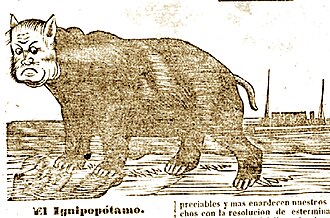El Cabichuí
| Type | Newspaper |
|---|---|
| Founded | May 13, 1867 |
| Political alignment | Paraguayan nationalism |
| Ceased publication | August 20, 1868 |
| Country | Paraguay |
El Cabichuí was an early biweekly Paraguayan governmental trench newspaper, written and printed near the front during the Siege of Humaitá in the Paraguayan War, aimed at being read by the Paraguayan Army soldiery. Directed by Juan Crisóstomo Centurión and Natalicio Talavera, it had text both in Guarani and Spanish.[1] A bare month after Humaitá fell, it stopped being printed, as the war once again became mobile; by that point, it had ran for 95 issues.[a]
History
[edit]El Cabichuí was a very early example of a trench newspaper, born in a context where battle lines had been stagnant for more than a year during the Siege of Humaitá in the Paraguayan War. It was idealized as a tool for improving morale by the Paraguayan president, Francisco Solano López.[2] It was made via woodcut with a rustic press in López's headquarters (initially at Paso Pucú, and later at San Fernando, in today's Central Department).

The name Cabichuí refers to a species of black wasp common in Paraguay (probably the Polybia occidentalis) which was known for its painful sting. In each issue of the paper there was a caricature where a swarm of these wasps stung a black soldier; the racial theme of the Brazilian Army was a major news theme, with Emperor Pedro II and the Brazilian soldiers frequently depicted as monkeys by the Cabichuí and other Paraguayan official media.[3] The other allied nations also were similarly targeted, with Uruguayan leader Venancio Flores being called "Pedro II's little dog", and, together with Argentinian leader Bartolomé Mitre, "vampires, who rose from cover in the shadowy night sucking the blood of their brothers and friends", who wanted to leave the war.[4]

Directed by the foreign-educated Juan Crisóstomo Centurión, it had contributions from other intellectuals such as the priests Fidel Maíz and Geronimo Becchi.[2][5] Despite this, it's tone was mocking and heavy-handed, as it was aimed to be read by the soldiers of the army; due to this intent, it had text both in Guarani and Spanish, and sometimes even in Portuguese,[2] because some copies were snuck into the allied encampment by spies.[6] The British engineer George Thompson, who was serving with the Paraguayan forces at the time, described the paper's jokes as "rude" and "stupid".[7]
At least one member of its editorial corps was killed at the 1868 San Fernando massacre.[8]
Editorial
[edit]El Cabichuí interpreted the Triple Alliance War as a struggle for liberty, taking the Brazilian Empire as Paraguay's great enemy, a slave-holding empire against a republic. It painted battles which were defeats or at best inconclusive battles as great Paraguayan victories, and once claimed Mitre, the Argentinian president and general, had died at the front (incorrectly, for it had been the Argentinian vice-president who'd died)[9].
Most of what was published by the paper was reviewed by Solano López before it was put out.[10]
Notes
[edit]- ^ This is disputed: the National Library of Paraguay claims it ran for 95 issues, but Luc Capdevila claims it only ran for 87.
References
[edit]Citations
[edit]- ^ Centurión 1894, p. 322-323.
- ^ a b c Centurión 1894, p. 321.
- ^ Izecksohn 2013.
- ^ Campos & Segovia 2005.
- ^ Johansson 2014, p. 92.
- ^ Carmo 2020, p. 145.
- ^ Centurión 1894, p. 322.
- ^ Carmo 2020, p. 71.
- ^ Johansson 2014, p. 101-103.
- ^ Carmo 2020, p. 69.
Sources
[edit]- Campos, Hérib; Segovia, Cayetano (2005). El Periodismo de Guerra en el Paraguay (1864-1870). Le Paraguay à l'ombre de ses guerres. Paris MAL-EHESS-IEP. Paris. Retrieved 21 September 2024.
- Capdevila, Luc (2007). "O gênero da nação nas gravuras da imprensa de guerra paraguaia: Cabichuí e El Centinela, 1867-1868" (PDF). ArtCultura (in Spanish). 9 (14). Federal University of Uberlândia.
- Carmo, Michel G. do (2020). Imprensa e Representações: Imagens de crianças e mulheres no contexto da Guerra do Paraguai (1864-1870) (MsC thesis). Federal University of Grande Dourados.
- Centurión, Juan C. (1894). Memorias del coronel Juan Crisóstomo Centurión o sea reminiscencias históricas sobre la Guerra del Paraguay, vol. 2. Imprenta de Obras de J. A. Berra.
- Izecksohn, Vitor (2013). Portraying the enemy: the racial issue in the Paraguayan Illustrated Press (PDF). XXVII Simpósio Nacional de História. Natal. Retrieved 18 September 2024.
- Johansson, María (2014). "La noble propaganda de la libertad. Estrategias propagandísticas de la prensa paraguaya durante la Guerra de la Triple Alianza (1864-1870)" (PDF). Tinkuy (in Spanish). 21. University of Montreal.